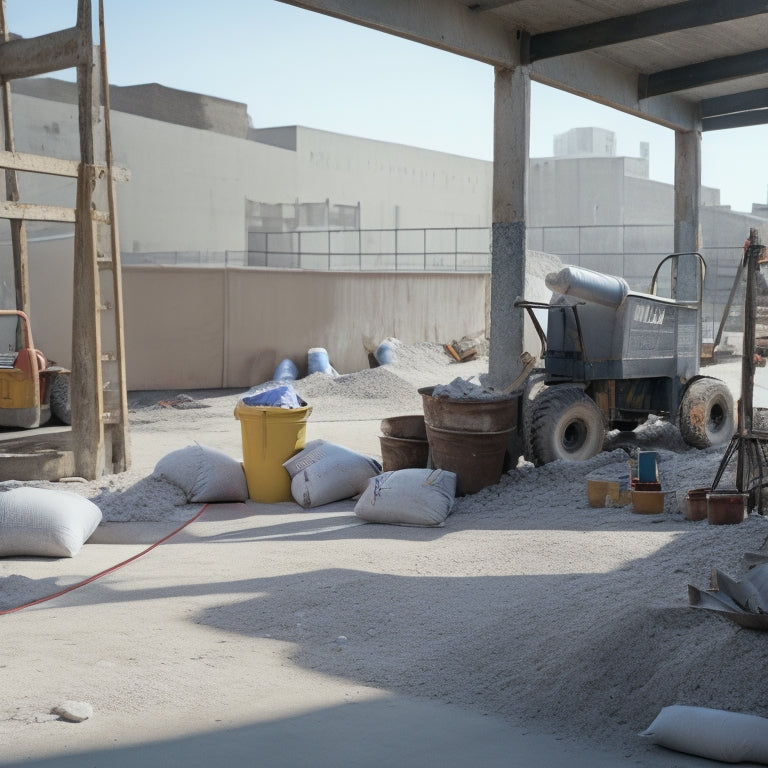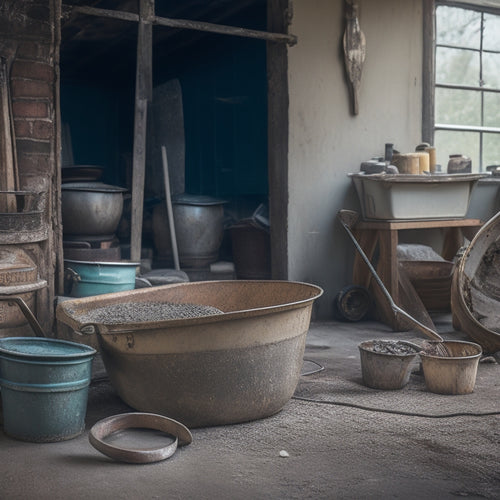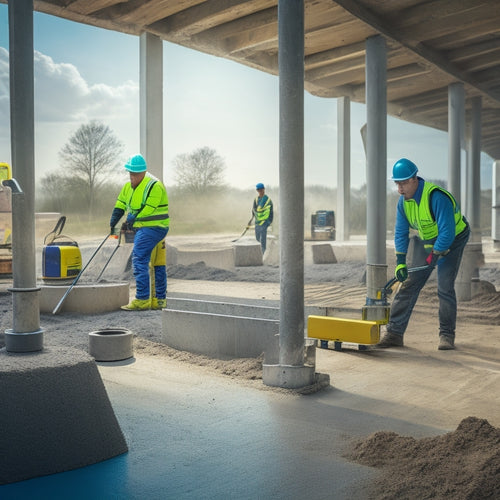
Essential Tools for Mixing and Placing Concrete
Share
When mixing and placing concrete, you'll need essential tools to achieve a strong, durable finish. Start with a sturdy mixing bucket, whether steel, plastic, or fiberglass, and pair it with a power tool like an electric mixer or drill with a mixing paddle. Hand tools like trowels, floats, and edging tools are must-haves for achieving a professional finish. Don't forget tamping and compacting tools, such as hand tampers and plate compactors, to remove air pockets and excess water. As you progress, you'll also need measuring and testing equipment, safety gear, and specialized tools to guarantee a successful concrete project - and that's just the beginning of your concrete journey.
Key Takeaways
• Mixing buckets, power tools, and specialized tools are essential for efficient and consistent concrete mixing.
• Hand tools like trowels, floats, and edging tools are necessary for achieving a professional finish in concrete placement.
• Tamping and compacting tools, including hand tampers and plate compactors, remove air pockets and excess water from freshly poured concrete.
• Measuring and testing equipment, such as slump cones and density testing devices, ensure concrete mixtures meet required specifications.
• Safety gear, including personal protective equipment and hazard awareness training, is crucial for protecting concrete workers from associated hazards.
Concrete Mixing Bucket Essentials
You'll regularly find a sturdy mixing bucket at the heart of every concrete mixing operation, serving as the primary vessel for combining and blending cement, aggregate, and water.
When it comes to mixing bucket types, you'll typically find steel, plastic, or fiberglass options. Steel buckets are durable and ideal for heavy-duty use, while plastic and fiberglass buckets are lighter and more corrosion-resistant.
Regardless of the type, regular bucket maintenance is vital to guarantee peak performance and extend its lifespan. You should regularly clean the bucket after each use, removing any residual concrete to prevent it from hardening and making future cleaning more difficult.
It's also essential to inspect the bucket for signs of wear and tear, such as cracks or rust, and replace it if necessary. Proper care and maintenance will help prevent contamination and guarantee a consistent mix, resulting in high-quality concrete.
Hand Tools for Concrete Work
When you're working with concrete, having the right hand tools can make all the difference in achieving a professional finish.
You'll need to guarantee you have the necessary tools to tamp and smooth the concrete, create clean edges, and accurately measure your work.
Tamping and Smoothing Tools
Three essential tamping and smoothing tools - the hand tamper, concrete float, and edger - are must-haves for achieving a smooth, even finish in concrete work. You'll use these tools to eliminate air pockets, excess water, and imperfections, guaranteeing a professional-looking result.
When it comes to tamping techniques, you'll need to master the proper way to use your hand tamper. This involves applying gentle to moderate pressure, depending on the specific job, to compress the concrete and remove air pockets. As you work, use a level to guarantee the surface remains even.
Smoothing methods come into play once the concrete has reached the desired consistency. Your concrete float will help you achieve a smooth, flat surface by removing excess water and evenly distributing the concrete.
Concrete Finishing Edges
Finishing edges requires precision and control, which is where hand tools like edgers, jointers, and groovers come into play. These tools allow you to achieve crisp, clean lines and precise joint formations, making them essential for creating professional-looking edges that enhance the overall appearance of your concrete projects.
When it comes to edge finishing techniques, you'll want to evaluate the following:
-
Edgers are used to create a clean, defined edge along the perimeter of your concrete slab or wall.
-
Jointers are used to create control joints, which help to control cracking and improve the overall structural integrity of your concrete.
-
Groovers are used to create decorative edge options, such as a rounded or beveled edge, adding a touch of elegance to your concrete work.
-
Edging tools can be used to create a variety of decorative edge options, including stamped, stenciled, or engraved designs.
-
Using the right edge finishing tools and techniques can make all the difference in achieving a professional-looking finish that will last for years to come.
Handheld Measuring Devices
You'll need accurate measurements to guarantee your concrete project meets specifications, which is where handheld measuring devices come into play, providing you with precise readings to guide your work.
Handheld scales, for instance, allow you to measure the weight of your mix accurately, ensuring you're meeting the required proportions. This is vital, as even slight deviations can affect the concrete's strength and durability.
Digital calipers are another essential handheld measuring device. They enable you to measure the thickness, width, and length of your concrete slabs or structures with precision. This is particularly important when working with complex designs or tight tolerances. With digital calipers, you can take precise readings quickly and easily, ensuring your work meets the required specifications.
When choosing handheld measuring devices, look for ones that are durable, easy to use, and provide accurate readings. Consider devices with features like waterproofing, shock resistance, and large displays for easy reading.
Power Tools for Mixing Concrete
For efficient concrete mixing, turn to power tools like drills and mixers that can tackle heavy loads and reduce mixing time. As you prepare to mix your concrete, consider investing in electric mixers or portable mixers that can handle large quantities of material. These power tools are designed to make your job easier and more efficient.
Here are some key benefits of using power tools for mixing concrete:
-
Increased speed: Electric mixers can mix large batches of concrete in a fraction of the time it takes to mix by hand.
-
Improved consistency: Portable mixers guarantee a consistent mix, which is critical for achieving the desired strength and texture of the concrete.
-
Reduced fatigue: Let the power tool do the heavy lifting, so you can focus on other tasks without getting tired.
-
Enhanced precision: With precise control over the mixing process, you can achieve the perfect mix every time.
-
Cost-effective: Investing in a power tool for mixing concrete can save you time and money in the long run.
Concrete Finishing Tool Options
Once you've mixed your concrete to the perfect consistency, it's time to focus on the final touches, and that's where concrete finishing tool options come into play.
You'll need the right tools to achieve the desired surface textures and finishing techniques. A trowel is a must-have for smoothing out the concrete and removing excess material. You'll also want a float to further refine the surface, creating a smooth, even finish.
For more intricate work, such as creating patterns or textures, you'll need a set of edging tools. These can include jointers, edgers, and groovers, which allow you to add detailed features to your concrete surface.
Depending on the specific finishing techniques you're using, you may also need specialized tools like a fresno or a bull float.
Tamping and Compacting Tools
Tamping and compacting tools are essential for removing air pockets and excess water from freshly poured concrete, ensuring a strong and stable foundation. As you work with concrete, you'll need these tools to achieve the desired consistency and structure.
To master tamping techniques and compacting methods, you'll need the right equipment. Here are some essential tools to include in your arsenal:
-
Hand tampers: ideal for small areas and tight spaces
-
Plate compactors: suitable for larger areas and providing high-impact force
-
Rammers: great for compacting soil and aggregate materials
-
Vibratory compactors: effective for compacting large areas and dense materials
-
Compaction testing devices: necessary for ensuring the concrete has reached the desired level of compaction
Measuring and Testing Equipment
When you're mixing concrete, you need to guarantee that the mixture meets the required specifications.
To do this, you'll need to measure and test the concrete's properties, such as its slump, density, and moisture content.
Concrete Slump Measurement
You'll need a slump cone and a tamping rod to measure the slump of freshly mixed concrete, a critical step in guaranteeing the material meets project specifications. The slump test is a consistency evaluation that determines the workability of the concrete, which is essential for achieving the desired strength and durability.
Here's how to perform a slump test:
-
Fill the slump cone with freshly mixed concrete, making sure to maintain a consistent density.
-
Use the tamping rod to compact the concrete in three layers, each consisting of 25 strokes.
-
Remove the cone and measure the slump, which is the distance the concrete settles from its original height.
-
Compare the measured slump to the project specifications to guarantee the concrete meets the required consistency.
-
Record the results to maintain quality control and make adjustments to the mix design if necessary.
Concrete Density Testing
After confirming the concrete meets the required consistency through slump testing, it's time to verify its density using specialized equipment.
Concrete density testing is essential to determine the quality and performance of the final product. You'll need to use testing methods that provide accurate results, as incorrect density can lead to structural issues or even collapse.
You'll typically use one of two methods: the nuclear density gauge or the sand cone method.
The nuclear density gauge is a non-destructive testing device that measures concrete density by detecting gamma radiation. This method is quick and easy, providing instant results.
The sand cone method, on the other hand, involves filling a hole with sand and measuring the volume of sand required to fill it. This method is more time-consuming but provides highly accurate results.
When choosing a testing method, consider factors such as site conditions, equipment availability, and the required level of accuracy.
Moisture Content Analysis
Measuring the moisture content of concrete is essential to confirm proper curing, as excessive moisture can lead to weakened structures. You must rely on specialized equipment to achieve accurate readings.
You can't afford to get it wrong, as the impact of moisture on concrete's strength and durability is significant. To confirm accurate moisture measurement, you'll need to employ reliable moisture measurement techniques.
Here are some essential tools for moisture content analysis:
-
Moisture meters: These handheld devices measure the electrical impedance of concrete, which is affected by moisture levels. They provide quick and non-destructive readings.
-
Karl Fischer titration: A laboratory-based technique that uses a chemical reaction to quantify moisture content. It's highly accurate but requires skilled operators and specialized equipment.
-
Thermogravimetric analysis: This laboratory method measures the weight loss of a concrete sample as it's heated, providing an accurate measure of moisture content.
-
Infrared thermometry: This non-invasive technique uses infrared radiation to measure the temperature of the concrete, which is affected by moisture levels.
-
Calcium carbide method: A simple, low-cost technique that uses a chemical reaction to estimate moisture content. However, it's less accurate than other methods.
Safety Gear for Concrete Workers
Wearing personal protective equipment (PPE) is essential for concrete workers, as it shields them from the multiple hazards associated with mixing and handling concrete.
As you work with concrete, you'll be exposed to dust, chemical splashes, and physical hazards like falling objects or tripping. Without proper protection, you're at risk of serious injury or even long-term health problems.
You should invest in a thorough set of PPE, including hard hats, safety glasses, gloves, respirators, and steel-toed boots.
Don't forget to include a dust mask or respirator to protect yourself from inhaling concrete dust and other airborne particles.
Additionally, consider undergoing hazard awareness training to identify potential risks and take proactive measures to mitigate them.
Concrete Placement Accessories
When pouring concrete, you'll need a range of concrete placement accessories to guarantee a smooth, even finish and prevent defects. These accessories play an essential role in ensuring that your concrete is placed correctly, and they can greatly impact the final result.
Here are some key concrete placement accessories you should consider:
-
Concrete finishing trowels: These are used to smooth and finish the surface of the concrete, removing any imperfections or air pockets.
-
Edging tools: These are used to create clean, defined edges around the concrete, such as around walls or curbs.
-
Concrete floats: These are used to level and smooth out the concrete, removing any excess water or air.
-
Bull floats: These are used to smooth and flatten large areas of concrete, creating an even surface.
-
Concrete screeds: These are used to level and smooth out the concrete, creating a perfectly flat surface.
Cleanup and Removal Tools
You'll need a set of specialized cleanup and removal tools to efficiently remove excess concrete, clean your equipment, and prepare the site for future use. These tools will help you adopt effective cleanup techniques and removal methods that save time and reduce waste.
A wire brush or scraper is essential for removing dried concrete from your mixing equipment and tools. A putty knife or trowel is ideal for scraping excess concrete from surfaces, while a broom or dustpan helps with sweeping up debris. For more stubborn concrete residue, a chemical cleaner or degreaser may be necessary.
Don't forget a hose or pressure washer to rinse away any remaining concrete and cleaning solutions. By having these cleanup and removal tools at your disposal, you'll be able to implement efficient cleanup techniques and removal methods that guarantee a clean and safe work environment.
This won't only protect your equipment and tools but also prevent accidents and reduce the risk of damage to surrounding surfaces.
Specialized Concrete Tools Needed
Several specialized concrete tools are required to accurately mix, pour, and finish concrete, including a mixing bucket, a concrete mixer, or a drill with a mixing paddle attachment. These tools are crucial for achieving the right consistency and finish for your project.
As you work with concrete, you'll realize that having the right tools can make all the difference in the quality of your work.
Here are some additional specialized concrete tools you may need:
-
A bull float: used to flatten and smooth out freshly poured concrete
-
A tamping tool: used to compact and level concrete
-
A jointer or edger: used to create clean joints and edges in concrete
-
A concrete finishing broom: used to create a textured finish on concrete
-
A concrete saw or grinder: used to cut or grind concrete for repairs or renovations
Remember to always follow essential safety practices when working with concrete, including wearing protective gear and guaranteeing a safe working environment.
Stay up-to-date with the latest concrete tool innovations to guarantee you're working efficiently and effectively.
Frequently Asked Questions
Can I Use a Regular Drill to Mix Small Batches of Concrete?
You can use a regular drill for small batches, but it's not ideal; consider a drill with a hammer function or a dedicated mixer for efficient mixing techniques, especially when working with thicker drill types.
How Often Should I Clean and Maintain My Concrete Tools?
Did you know that 75% of concrete tool failures occur due to poor maintenance? You'll want to clean your tools after each use and schedule regular maintenance every 3-6 months to prevent corrosion and extend their lifespan.
What Is the Ideal Temperature for Placing and Curing Concrete?
When placing and curing concrete, you should aim for temperatures between 50°F and 75°F to guarantee ideal concrete temperature effects, as extreme temperatures can compromise curing conditions, affecting strength, durability, and overall concrete quality.
Can I Mix Concrete in a Wheelbarrow Instead of a Bucket?
You can mix concrete in a wheelbarrow, leveraging its advantages like larger capacity and ease of mixing. Employ mixing techniques like folding and scraping to guarantee thorough blending, but be prepared for a more physically demanding process.
How Do I Prevent Concrete From Sticking to My Tools and Equipment?
To prevent concrete from sticking to your tools and equipment, you'll want to apply tool coatings or release agents, such as oil or silicone-based products, which will reduce adhesion and make cleanup a whole lot easier.
Conclusion
As you wrap up your concrete project, remember that having the right tools is like holding the keys to a well-oiled machine - it's the difference between a smooth, efficient process and a frustrating, time-consuming one.
With these essential tools for mixing and placing concrete, you'll be well-equipped to tackle any project that comes your way.
Related Posts
-

Top Tools for Mixing Concrete at Home
When mixing concrete at home, you'll need a range of tools to guarantee a successful operation. Start with essential ...
-

Why These Tools Are Crucial for Concrete Patio
You're about to commence on a concrete patio project, and having the right tools is vital to achieving professional-l...
-

What Tools Ensure Precise Concrete Leveling Results
You need a range of specialized tools to achieve precise concrete leveling results. Laser leveling instruments provid...


